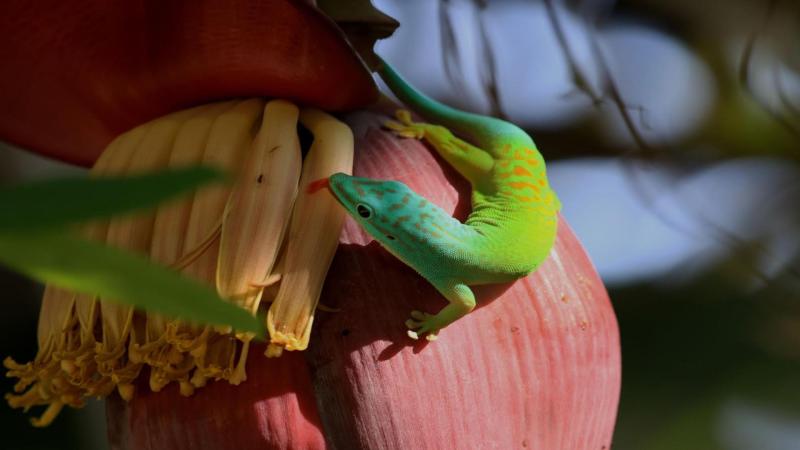
A male Andaman day gecko [Image Credits: Divija Murkoth]
The big, bright, green-coloured Andaman day gecko is a sight to behold; only that, you have to go all the way to the Andaman Islands to get a glimpse of it. Endemic to the islands, these geckos live in trees and are active during the day. Thanks to cash crops grown on these islands today, they can be found in plenty, feeding on bananas, coconuts and betel nuts. They belong to the genus called Phelsuma, believed to have evolved from Madagascar, an island about 6000 km away from the Andamans! A new study has traced their evolutionary history and has thrown some light on how they differ from the other geckos in the Andamans.
The study, by researchers from India, Germany and the UK, used DNA analysis to decipher the evolutionary tree of the Andaman day gecko (Phelsuma andamanensis) in its genus. It also assessed the genetic diversity and the population of these geckos in the islands. The study, funded by the Rufford Foundation, the Inlaks Shivdasani Foundation, the Ravi Sankaran Foundation, and the DAAD Doctoral Research grants, was published in the journal Scientific Reports.
The Andaman archipelago consists of around 300 islands divided into two groups—the Greater Andamans in the north and the Little Andaman in the south. These islands share their geological history with Asia. Scientists speculate that millions of years ago when the sea levels were low, these islands were connected to mainland Southeast Asia, and animals moved between the two. However, when sea levels rose, many of these animals were geographically isolated and evolved independently, becoming endemic to the islands and varying greatly in their genetic composition and distribution.
Painting the evolutionary picture
The current study on the Andaman day geckos found that they were one of the oldest species of the genus Phelsuma. Since there was no human interference in the islands for millions of years, they originated and colonised the Andamans naturally, and hence, have very high genetic diversity. Islands within the Andamans have separated into smaller landmasses by sea but the Andaman day gecko's populations do not seem to mind the water. This does not mean they can swim over to neighbouring islands, but human-induced changes, through inter-island movement, have also contributed to their regular movement.

A male and female Andaman day Gecko [Image Credits: Sanjay Prasad]
“Our study shows that unlike species on Mauritius, La Reunion, Comoros Islands in the western part of the Indian Ocean, this species has not undergone further diversification into different species after colonising the Andaman Islands,” says Ms Ashwini V. Mohan, the lead author of the study. She is a research scholar at the Braunschweig University of Technology, Germany. “On the contrary, gene flow between island populations, facilitated due to lowered sea levels and human-mediated transport, has resulted in a single large population over the islands,” she adds.
The study also identified two populations that were genetically similar but geographically distinct. The 'north' cluster had individuals sampled from islands in the upper half of the archipelago and the south cluster the lower half. The researchers say that these two clusters were formed before the onset of the last ice age. The early humans, who inhabited the Little Andaman, were restricted to the island owing to the vast expanse of ocean and greater geographical distance to the closest island. However, what led to the creation of these two clusters remains a mystery.
Human activities responsible for increased numbers
In recent centuries, the growth of cash crops, like banana and betel nuts, seem to have changed the distribution of the Andaman day gecko. Since they are a generalist species—readily adapting to and benefiting from human activities—they have expanded without boundaries. But, is this surge in the population a good thing? Not necessarily, say the researchers.
“Population size is not the only measure of a species’ success because population health is an important factor for its survival. Highly dense populations attract more parasites and diseases. We do not yet know the implications of such high-density gecko populations on the population health of the Andaman day gecko,” explains Ms Mohan.

A female Andaman day gecko [Image Credits: Divija Murkoth]
The researchers also compared the populations of the Andaman day geckos with other endemic geckos, like the bent-toed gecko (Cyrtodactylus rubidus) and the giant gecko (Gekko verreauxi). They found a poor geographic structure in the spread of the Andaman day geckos, where the boundaries were not well defined. The high adaptability of these geckos to plantations and the inter-island food trade could have resulted in a single expanding population, say the researchers.
The findings highlight how changes due to human activities can affect endemic species, especially those in vulnerable islands.
“Island reptiles are in danger. More than 70% of reptile extinctions in the last 50,000 years have taken place on islands. Studies like ours, focussing on the genetic diversity and spatial distribution of animals, will play a key role in prioritising conservation efforts,” says Ms Mohan, on their implications. “With increasing developmental pressures, it is crucial to identify critical islands that need conservation efforts,” she signs off.
This article has been edited for factual changes as per the researcher’s inputs, whose work is covered. The error is regretted.

![Inset: image of Snowflake yeast. Credit: Narayanasamy N, Bingham E, Fadero T, Ozan Bozdag G, Ratcliff WC, Yunker P, Thutupalli S. Metabolically-driven flows enable exponential growth in macroscopic multicellular yeast. bioRxiv [Preprint]. 2024 Jun 22:2024.06.19.599734. doi: 10.1101/2024.06.19.599734. PMID: 38948761; PMCID: PMC11213004. Yeast](/sites/researchmatters/files/styles/400px_wide/public/Snowfalke%20Yeast.jpg?itok=YZoahBjb)




